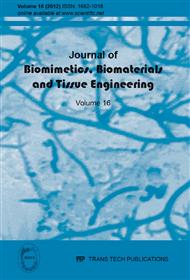[1]
Archibald LK. Gayness RP. Hospital acquired infections in the United States: the importance of interhospital comparisons. Infectious Disease Clinics of North America 1997; 11(2): 245-255.
DOI: 10.1016/s0891-5520(05)70354-8
Google Scholar
[2]
Costerton JW, Stewart PS, Greenberg EP. Bacterial biofilms: a common cause of persistent infections. Science; 1999; (284): 1318-1322.
DOI: 10.1126/science.284.5418.1318
Google Scholar
[3]
Nichols RL, Raad II. Management of bacterial complications in critically ill patients: surgical wound and catheter-related infections. Diagnose microbiology infectious disease 1999; 33(2): 121-130.
DOI: 10.1016/s0732-8893(98)00144-8
Google Scholar
[4]
Stewart PS, Costerton JW. Antibiotic resistance of bacteria in biofilms. Lancet 2001; 358(9276): 135-138.
DOI: 10.1016/s0140-6736(01)05321-1
Google Scholar
[5]
Gristina AG, Hobgood CD, Webb LX. Adhesive colonization of biomaterials and antibiotic resistance. Biomaterials 1987; 8(6): 423-426.
DOI: 10.1016/0142-9612(87)90077-9
Google Scholar
[6]
Vuong C, Otto M. Staphylococcus epidermidis infections. Microbes and infection 2002; 4(4): 481-489.
DOI: 10.1016/s1286-4579(02)01563-0
Google Scholar
[7]
Fux CA, Costerton JW, Stewart PS et al. Survival strategies of infectious biofilms. Trends in Microbiology 2005; 13(1) , 34-40.
DOI: 10.1016/j.tim.2004.11.010
Google Scholar
[8]
Gerson DF, Scheer D. Cell surface energy, contact angle and phase partition III, Adhesion of bacterial cells to hydrophobic surfaces. Biochim. Biophys. Acta 1980; 602: 506-510.
DOI: 10.1016/0005-2736(80)90329-6
Google Scholar
[9]
Yu DG, Teng MY, Chou WL, Yang MC. Characterization and inhibitory effect of antibacterial PAN-based hollow fiber loaded with silver nitrate. Journal of Membrane Science 2003; 225: 115-123.
DOI: 10.1016/j.memsci.2003.08.010
Google Scholar
[10]
Zhang W, Chu PK, Ji JH . Antibacterial Properties of Plasma-Modified and Triclosan or Bronopol Coated Polyethylene. Polymer 2006; 47(3): 931-936.
DOI: 10.1016/j.polymer.2005.12.009
Google Scholar
[11]
Furno F, Morley KS, Wong B, et al. Silver nanoparticles and polymeric medical devices: a new approach to prevention of infection. Journal of Antimicrobial Chemotherapy 2004; 54(6): 1019-1024.
DOI: 10.1093/jac/dkh478
Google Scholar
[12]
Kalyon BD, Olgun U. Antibacterial efficacy of triclosan-incorporated polymers. American Journal of Infection Control. 2001; 29(2): 124-125.
DOI: 10.1067/mic.2001.113229
Google Scholar
[13]
Schweizer HP. Triclosan: a widely used biocide and its link to antibiotics. FEMS Microbiology Letters. 2001; 202(1-7): 1-7.
DOI: 10.1111/j.1574-6968.2001.tb10772.x
Google Scholar
[14]
Francolini I, Donelli G, Stoodley P. Polymer designs to control biofilm growth on medical devices. Rev Environ Sci Bio/Technol 2003; 2(2-4): 307-319.
DOI: 10.1023/b:resb.0000040469.26208.83
Google Scholar
[15]
Brady RA, Leid JG, Camper AK, Costerton JW, Shirtliff ME. Identification of Staphylococcus aureus Proteins Recognized by the Antibody-Mediated Immune Response to a Biofilm Infection. Infection and Immunity, 2006; 74(6): 3415-3426.
DOI: 10.1128/iai.00392-06
Google Scholar
[16]
Ji JH, Zhang W,Bacterial behaviors on polymer surfaces with organic and inorganic antimicrobial compounds. Journal of Biomedical Materials Research. 2009; 88A(2): 448-453.
DOI: 10.1002/jbm.a.31759
Google Scholar
[17]
Cook G, Costerton JW, Darouiche RO. Direct confocal microscopy studies of the bacterial colonization in vitro of a silver-coated heart valve sewing cuff. International Journal of Antimicrobial Agents. 2000; 13(3): 169-173.
DOI: 10.1016/s0924-8579(99)00120-x
Google Scholar
[18]
Braoudaki M, Hilton AC. Mechanisms of resistance in Salmonella enterica adapted to erythromycin, benzalkonium chloride and triclosan. International Journal of Antimicrobial Agents 2005; 25: 31-37.
DOI: 10.1016/j.ijantimicag.2004.07.016
Google Scholar
[19]
ISO 21996-2007(E) : Plastics Measurement of antibacterial activity on plastics surfaces.
Google Scholar
[20]
Hope CK, Wilson M. Biofilm structure and cell vitality in a laboratory model of subgingival plaque. Journal of Microbiological Methods 2006; 66(3): 390-398.
DOI: 10.1016/j.mimet.2006.01.003
Google Scholar
[21]
Tatar EC, Unal FO, Tatar I, et al. Investigation of surface changes in different types of ventilation tubes using scanning electron microscopy and correlation of findings with clinical follow-up. International Journal of Pediatric Otorhinolaryngology 2006; 70(3): 411-417.
DOI: 10.1016/j.ijporl.2005.07.005
Google Scholar
[22]
Little B, Wagner P, Ray R, Pope R, Scheetz R, Biofilms: An ESEM evaluation of artifacts introduced during SEM preparation. Journal of Industrial Microbiology and Biotechnology 1991; 8( 4): 213-221.
DOI: 10.1007/bf01576058
Google Scholar
[23]
Hope CK, Wilson M. Measuring the thickness of an outer layer of viable bacteria in an oral biofilm by viability mapping. Journal of Microbiological Methods 2003; 54: 403-410.
DOI: 10.1016/s0167-7012(03)00085-x
Google Scholar
[24]
Jefferson KK. What drives bacteria to produce a biofilm. FEMS Microbiology Letters 2004; 236: 163-173.
DOI: 10.1111/j.1574-6968.2004.tb09643.x
Google Scholar
[25]
Valle J, Toledo-Arana A, Berasain C, Ghigo JM, Amorena B, Penades JR, Lasa, I. SarA and not sigma(B) is essential for biofilm development by Staphylococcus aureus. Molecular Microbiology. 2003; 48: 1075-1087.
DOI: 10.1046/j.1365-2958.2003.03493.x
Google Scholar
[26]
Corona-Izquierdo FP. Membrillo-Hernandez J. A mutation in rpoS enhances biofilm formation in Escherichia coli during exponential phase of growth. FEMS Microbiology Letters. 2002; 211: 105-110.
DOI: 10.1111/j.1574-6968.2002.tb11210.x
Google Scholar
[27]
Shapiro JA. Thinking about bacterial populations as multicellular organisms. Annual Review of Microbiology 1998; 52: 81-104.
DOI: 10.1146/annurev.micro.52.1.81
Google Scholar
[28]
Federle MJ, Bassler BL. Interspecies communication in bacteria. Journal of Clinical Investigation 2003; 112: 1291-1299.
DOI: 10.1172/jci20195
Google Scholar
[29]
Kong KF, Vuong C, Otto M, Staphylococcus quorum sensing in biofilm formation and infection, International Journal of Medical Microbiology, 2006; 296( 2), 133-139.
DOI: 10.1016/j.ijmm.2006.01.042
Google Scholar
[30]
Li MY, Zhang J, Lu P, Xu JL,Li SP. Evaluation of Biological Characteristics of Bacteria Contributing to Biofilm Formation. Pedosphere 2009; 19(5): 554-561.
DOI: 10.1016/s1002-0160(09)60149-1
Google Scholar


